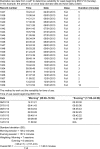A pragmatic behavior-based habit index for adherence to nebulized treatments among adults with cystic fibrosis
- PMID: 30863018
- PMCID: PMC6388736
- DOI: 10.2147/PPA.S186417
A pragmatic behavior-based habit index for adherence to nebulized treatments among adults with cystic fibrosis
Abstract
Background: Habit, a psychological process that automatically generates urges to perform a behavior in associated settings, is potentially an important determinant of medication adherence. Habit is challenging to measure because, as a psychological construct, it cannot be directly observed. We describe a method of using routinely available objective adherence data from electronic data capture (EDC) to generate a behavior-based index of adherence habit and demonstrate how this index can be applied.
Methods to generate the habit index: Our proposed habit index is a "frequency in context" measure. It estimates habit as a multiplicative product of behavior frequency (generated from weekly percentage adherence) and context stability (inferred from time of nebulizer use). Although different timescales can be used, we chose to generate weekly habit scores since we believe that this is the most granular level at which context stability can be reasonably calculated.
An application of the habit index: A hallmark of habit is to predict future behavior, hence we used time series method to cross-correlate the habit index with nebulizer adherence in the subsequent week among 123 adults with cystic fibrosis (52, 42.3% female; median age 25 years) over a median duration of 153 weeks (IQR 74-198 weeks). The mean cross-correlation coefficient (R) between the habit index and subsequent adherence was 0.40 (95% CI 0.36-0.44). Adjusting for current adherence, the unstandardized regression coefficient (B) for the habit index was 0.30 (95% CI -1.04 to 1.65).
Conclusion: We have described a pragmatic method to infer "habit" from adherence data routinely captured with EDC and provided proof-of-principle evidence regarding the feasibility of this concept. The continuous stream of data from EDC allows the habit index to unobtrusively assess "habit" at various time points over prolonged periods, and hence the habit index may be applicable in habit formation studies.
Keywords: cystic fibrosis; habits; medication adherence; nebulizers and vaporizers.
Conflict of interest statement
Disclosure This report is independent research arising from a doctoral research fellowship to Zhe Hui Hoo (DRF-2014-07-092 and supported by the National Institute for Health Research. The views expressed in this publication are those of the author(s) and not necessarily those of the NHS, the National Institute for Health Research, or the Department of Health. The other authors report no conflicts of interest in this work.
Figures



Similar articles
-
Role of habit in treatment adherence among adults with cystic fibrosis.Thorax. 2019 Feb;74(2):197-199. doi: 10.1136/thoraxjnl-2017-211453. Epub 2018 Jun 9. Thorax. 2019. PMID: 29886416 Clinical Trial.
-
An intervention to support adherence to inhaled medication in adults with cystic fibrosis: the ACtiF research programme including RCT.Southampton (UK): NIHR Journals Library; 2021 Oct. Southampton (UK): NIHR Journals Library; 2021 Oct. PMID: 34665573 Free Books & Documents. Review.
-
Using a learning health system to understand the mismatch between medicines supply and actual medicines use among adults with cystic fibrosis.J Cyst Fibros. 2022 Mar;21(2):323-331. doi: 10.1016/j.jcf.2021.09.007. Epub 2021 Sep 23. J Cyst Fibros. 2022. PMID: 34565705
-
Mechanisms of Action of a Web-Based Intervention With Health Professional Support to Increase Adherence to Nebulizer Treatments in Adults With Cystic Fibrosis: Qualitative Interview Study.J Med Internet Res. 2020 Oct 6;22(10):e16782. doi: 10.2196/16782. J Med Internet Res. 2020. PMID: 32697197 Free PMC article.
-
Folic acid supplementation and malaria susceptibility and severity among people taking antifolate antimalarial drugs in endemic areas.Cochrane Database Syst Rev. 2022 Feb 1;2(2022):CD014217. doi: 10.1002/14651858.CD014217. Cochrane Database Syst Rev. 2022. PMID: 36321557 Free PMC article.
Cited by
-
Correlation Between Objective Habit Metrics and Objective Medication Adherence: Retrospective Study of 15,818 Participants From Clinical Studies.Interact J Med Res. 2025 Feb 6;14:e63987. doi: 10.2196/63987. Interact J Med Res. 2025. PMID: 39914802 Free PMC article.
-
Adherence to 6-Mercaptopurine (6-MP) and Habit Strength in Pediatric Acute Lymphoblastic Leukemia (ALL).Eur J Haematol. 2025 May;114(5):864-871. doi: 10.1111/ejh.14386. Epub 2025 Jan 20. Eur J Haematol. 2025. PMID: 39832489 Free PMC article.
-
Habit Strength, Medication Adherence, and Habit-Based Mobile Health Interventions Across Chronic Medical Conditions: Systematic Review.J Med Internet Res. 2020 Apr 28;22(4):e17883. doi: 10.2196/17883. J Med Internet Res. 2020. PMID: 32343250 Free PMC article.
-
Time-of-Day Differences in Treatment-Related Habit Strength and Adherence.Ann Behav Med. 2021 Mar 20;55(3):280-285. doi: 10.1093/abm/kaaa042. Ann Behav Med. 2021. PMID: 32542355 Free PMC article.
-
Time of Day Preferences and Daily Temporal Consistency for Predicting the Sustained Use of a Commercial Meditation App: Longitudinal Observational Study.J Med Internet Res. 2023 Apr 10;25:e42482. doi: 10.2196/42482. J Med Internet Res. 2023. PMID: 37036755 Free PMC article.
References
-
- Chowdhury R, Khan H, Heydon E, et al. Adherence to cardiovascular therapy: a meta-analysis of prevalence and clinical consequences. Eur Heart J. 2013;34(38):2940–2948. - PubMed
-
- Sokol MC, McGuigan KA, Verbrugge RR, Epstein RS. Impact of medication adherence on hospitalization risk and healthcare cost. Med Care. 2005;43(6):521–530. - PubMed
-
- Butler JA, Roderick P, Mullee M, Mason JC, Peveler RC. Frequency and impact of nonadherence to immunosuppressants after renal transplantation: a systematic review. Transplantation. 2004;77(5):769–776. - PubMed
-
- Osterberg L, Blaschke T. Adherence to medication. N Engl J Med. 2005;353(5):487–497. - PubMed
Grants and funding
LinkOut - more resources
Full Text Sources
Research Materials

